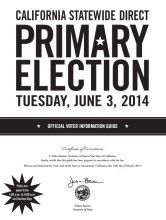June voter guide gives candidates’ visions for CA
by John Seiler | April 30, 2014 5:26 pm
 Are you ready for some campaigning?
Are you ready for some campaigning?
In recent days voters have received in the mail Official Voter Information Guide[1] for the June 3 primary election. It conveniently lists every candidate for office and the two propositions on the ballot: Proposition 41, $600 million for veterans’ housing bonds. And Proposition 42, altering the state open-meetings law.
It also includes statements from the candidates, but only from those who have accepted California’s voluntary limits on campaign spending, which vary by office. For example, gubernatorial candidates’ limit is $8.2 million. Incumbent Gov. Jerry Brown already has at least doubled that with more than $17 million[2] and counting raised so far. So there’s no statement included from him.
The reason is that candidates with a lot of campaign cash already have the means to get their message out to voters.
The voluntary limit for the other statewide offices — lieutenant governor, attorney general, etc. — is $5.4 million. For candidates for the board of equalization, the limit is $1.4 million.
This is the first campaign for these offices under the new Top Two system. The two candidates with the most votes June, regardless of party (or no party), go on to the November runoff.
Candidates for governor
Fifteen candidates are running for governor. All the included statements[3] are worth reading just to get an idea of what’s going on in the state. A couple are worth reporting on here.
Beside Brown, the two best know are the top Republicans, Neel Kashkari, a financial executive, who is not running under the voluntary limit, so he has no statement; and Assemblyman Tim Donnelly, R-Hesperia, who has accepted the voluntary limit.
Donnelly, a traditional conservative Republican, filled up the full 250 words allowed, part of which said:
“I’m a Patriot not a Politician. At 19 when I came to California with $300 in my pocket, California was the land of opportunity. The only limitation on your dreams was what you could imagine and how hard you were willing to work. … I was living the California dream until oppressive regulations drove my customers out of the state and regulated me out of business. An ever-increasing government has become the greatest threat to our future. …
“As Governor, I will: Veto all new restrictions on your business, your freedom, and your constitutional civil rights. Never submit a budget that spends more than we take in. Treat jobs like we treat endangered species — protect them by any means necessary. Fight to lower tax rates for all hard-working Californians.”
Except in 2011 Donnelly voted to keep redevelopment agencies, which use eminent domain laws to take the property of homeowners and small businesses, often giving it to big box developments.
Cindy Sheehan
Of the other candidates for governor, the best known is anti-war activist Cindy Sheehan, who is running as a Peace and Freedom party candidate. She wrote a short piece:
“I am committed to all the people of California. Let’s work together to create a peaceful, prosperous, and environmentally clean and sustainable State with high quality education and health care for all, living wages, and community control of abusive police and prisons. I vow to tax the super-rich more to end poverty.”
A curious candidate is “Bo” Bogdan Ambrozewicz, running as an independent. He wrote:
“Independent: Non partisan, Uniting Californians. ‘Bo,’ Designer, builder, 35 years experience. Immigrated to California at age 10. Women’s and minority rights. No fees for new businesses for first year. 25% fee reduction for existing businesses. Accelerate business investment depreciation by 50%. Reduce property tax 50%. Reduce building permits 50%. Repeal fire tax. Reduce college tuition 25%. Senior discount plan. Immigration Reform. Repeal train and water tunnel to solve water issue.”
It’s a curious mix of libertarian and left-wing proposals. He doesn’t mention that it would mean cutting spending at least 25 percent.
Candidates for lieutenant governor
Among the eight candidates for lieutenant governor, incumbent Democrat Gavin Newsom is not following the voluntary campaign contribution limit of $5.4 million. But the top Republican candidate, former state GOP chairman Ron Nehring, has accepted the limit and wrote:
“California is home to the world’s most innovative and hard-working people, yet we’re crushed by high taxes and unemployment, plus the nation’s worst business climate for jobs. Let’s put Republican ideas into action and set clear priorities: Reform taxes to make them lower, simple and fair; Limit government spending; Set high standards and move control over education back to our local schools; Protect homeowners and seniors by safeguarding Proposition 13 and keep property taxes down….”
It’s pretty standard Republican rhetoric that used to win elections but hasn’t done so well in recent years.
Wrote Eric Korevaar, a Democrat:
“As a Ph.D. scientist rather than a career politician, I will bring needed analytical capabilities and innovative thinking to Sacramento. While simultaneously being the father of young children and a successful entrepreneur relying on good money management skills, I believe strongly that funding for schoolteachers and higher education should take precedence over spending on government overhead. Therefore, to set an example of fiscal restraint for other state officials, I will cut the Lieutenant Governor’s staff and budget by 50% and accept no pension.”
According to the state treasurer’s data site[4], as of 2012, the last year available, the lieutenant governor’s compensation included $17,077 for his defined-benefit pension plan.
Refusing to take a pension contribution is about the only thing the lieutenant governor, whose position is so irrelevant even Newsom has quipped it[5] might be best to eliminate it, has control over.
- Official Voter Information Guide: http://voterguide.sos.ca.gov/
- more than $17 million: http://www.nytimes.com/2014/02/28/us/brown-to-run-for-re-election-as-california-governor.html?_r=0
- included statements: http://voterguide.sos.ca.gov/candidates/governor.htm
- the state treasurer’s data site: http://www.publicpay.ca.gov/Reports/PositionDetail.aspx?employeeid=5396108
- Newsom has quipped it: http://blog.sfgate.com/nov05election/2012/02/24/california-lt-gov-gavin-newsom-says-his-job-should-be-dissolved-unless-changes-made/
Source URL: https://calwatchdog.com/2014/04/30/june-voter-guide-gives-candidates-visions-for-ca/